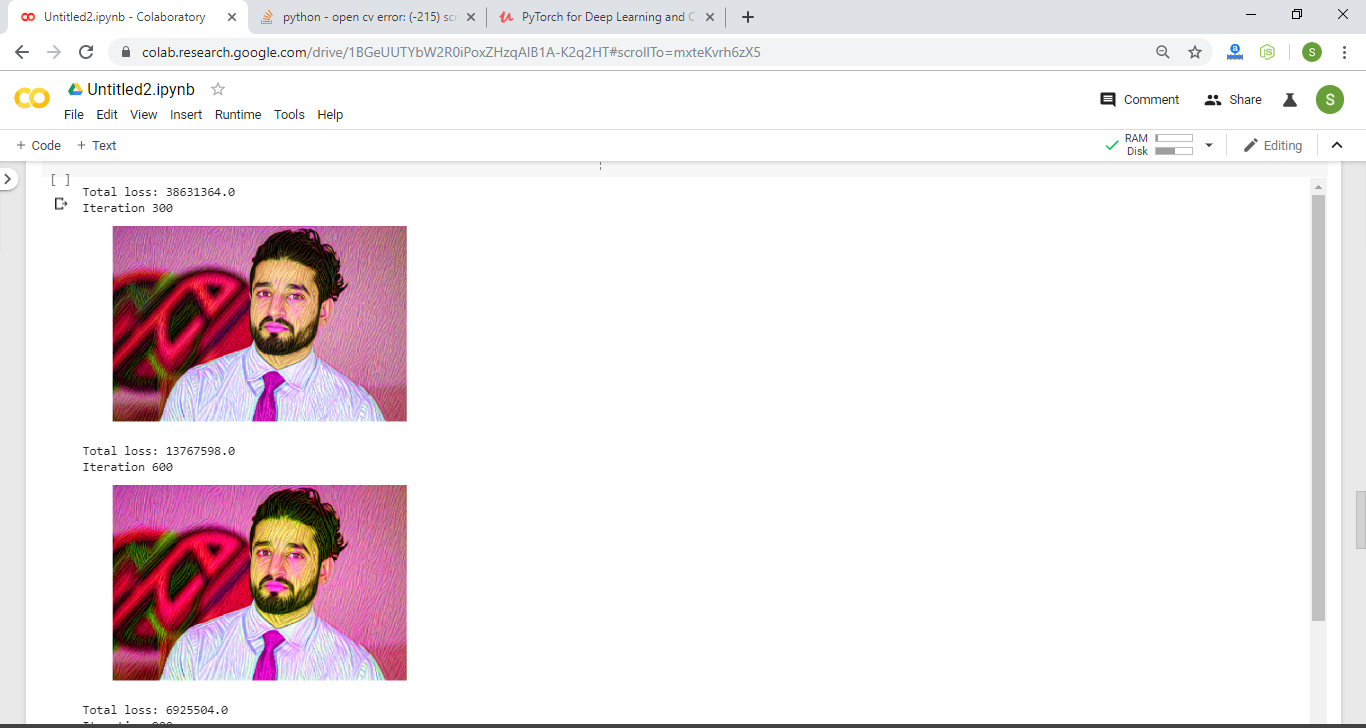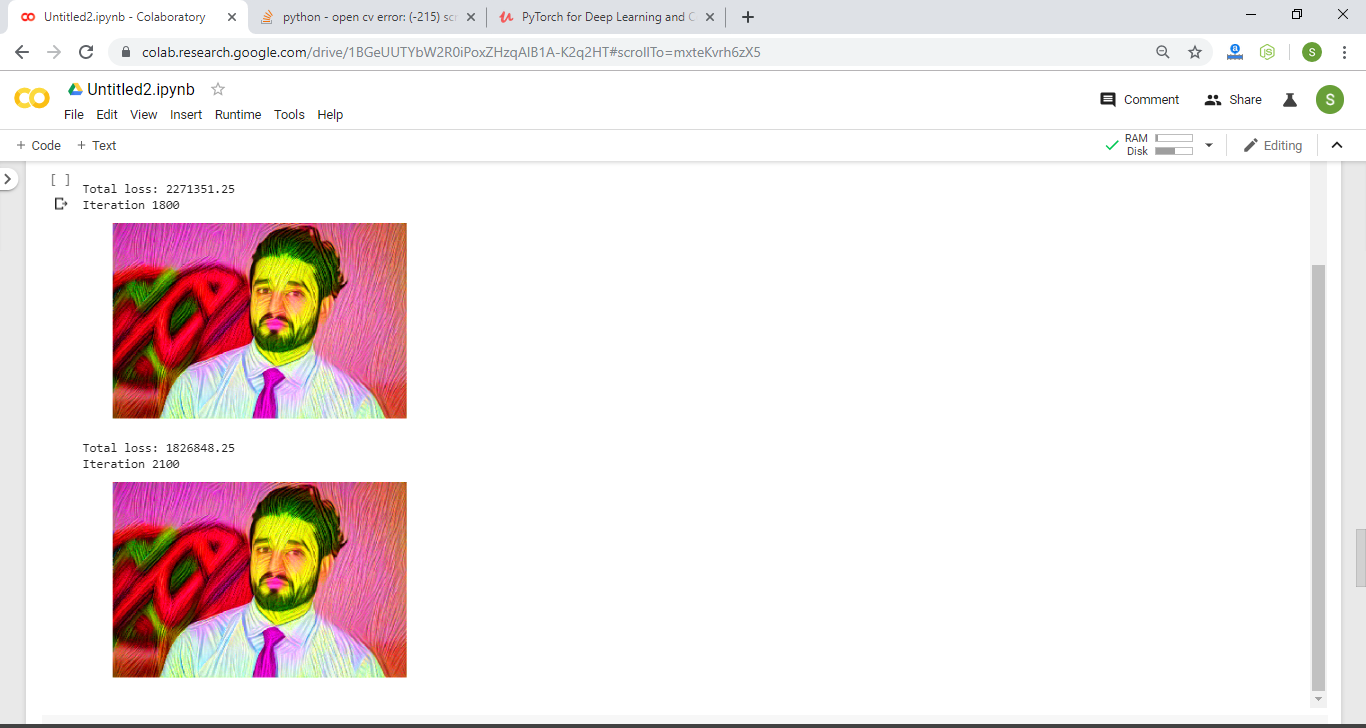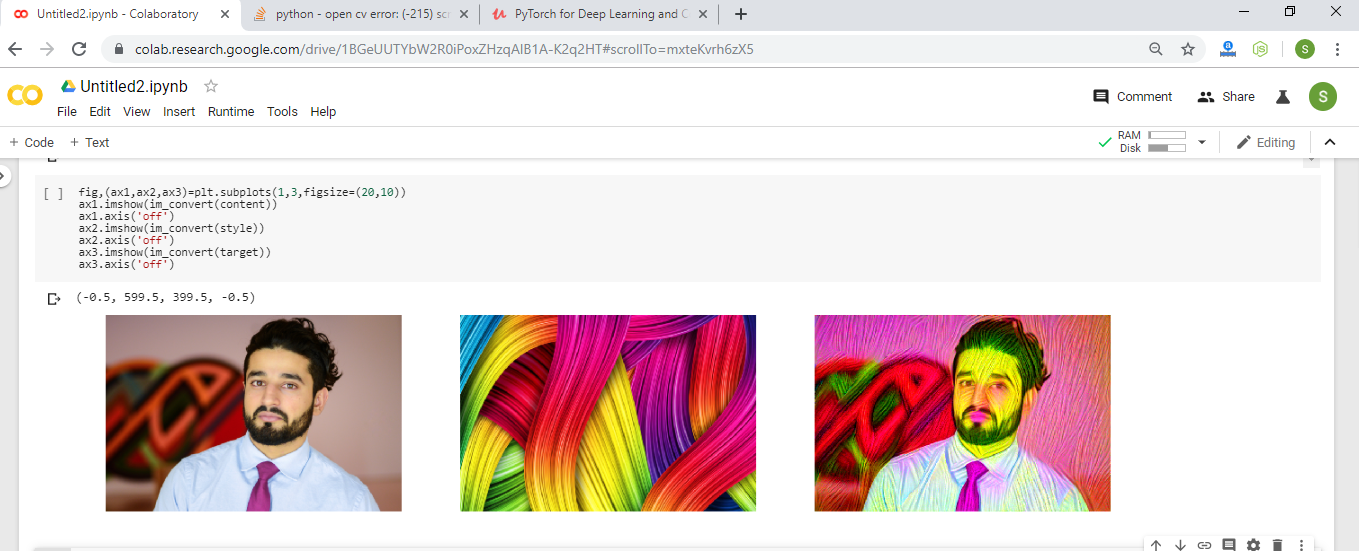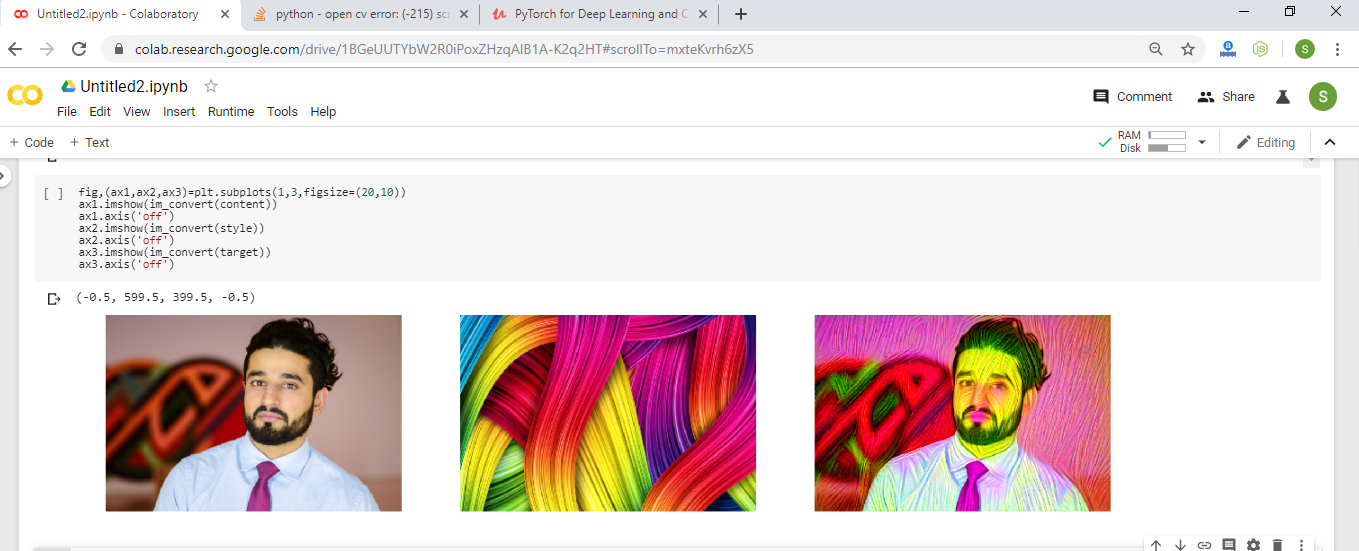📌 相关文章
- 块优化
- 凸优化-锥
- 凸优化-锥(1)
- 优化 javascript (1)
- 优化 javascript 代码示例
- 从另一个过程调用包的过程 (1)
- 将所有样式转换为内联样式 javascript (1)
- TensorFlow |样式转移的过程(1)
- TensorFlow |样式转移的过程
- 将所有样式转换为内联样式 javascript 代码示例
- 宏和过程的区别
- 宏和过程的区别(1)
- 循环优化
- 循环优化(1)
- 从另一个过程调用包的过程 - 无论代码示例
- 单变量优化与多变量优化(1)
- 单变量优化与多变量优化
- 测试和优化
- 测试和优化(1)
- WordPress-优化(1)
- WordPress优化(1)
- WordPress优化
- WordPress-优化
- 凸优化教程(1)
- 凸优化教程
- TensorFlow-优化器(1)
- TensorFlow 中的优化器
- TensorFlow 中的优化器(1)
- TensorFlow-优化器
📜 样式转换的优化过程
📅 最后修改于: 2020-11-11 01:16:19 🧑 作者: Mango
样式转移的优化过程
我们拥有所有三个图像,现在,我们可以执行优化过程。要执行优化过程,我们必须执行以下步骤:
步骤1:
第一步,我们定义一些基本参数,这些参数可以帮助我们直观地了解培训过程,并有助于我们简化培训过程。第一个参数每次都会向我们显示目标图像,以便我们可以检查优化过程。我们用目标图像定义Adam优化器,并设置目标学习率。最后但并非最不重要的一点是,我们定义了培训过程应采取的优化步骤的数量。
我们需要在结果和时间效率之间取得平衡,因为培训过程可能需要很长时间才能完成。因此,我们将定义步骤,在本例中,我们将步骤限制为2100。
show_every=300
optimizer=optim.Adam([target],lr=0.003)
steps=2100
第2步:
现在,我们实现了一些用于数据可视化的代码行。我们定义一个图像数组,它将在整个训练过程中存储目标图像。在训练过程之后,我们可以从这些图像中创建一个视频,以直观地了解样式和内容图像如何组合以优化目标图像。我们将解开目标图像的形状。
height,width,channels=im_convert(target).shape
image_array=np.empty(shape=(300,height,width,channels))
我们将定义一个捕获帧,它可以帮助我们每次捕获一个帧。最后,我们将定义一个计数器变量,该变量将跟踪数组索引。
capture_frame=steps/300
counter=0
优化的迭代过程
#Defining a loop statement from 1 to steps+1
for ii in range(1,steps+1): #To ensure that our loop runs for the defined number of steps
# Extracting feature for our current target image
target_features=get_features(target,vgg)
#Calculating the content loss for the iteration
content_loss=torch.mean((target_features['conv4_2']content_features['conv4_2'])**2)
#Initializing style loss
style_loss=0
#The style loss is the result of a combine loss from five different layer within our model.
#For this reason we iterate through the five style features to get the error at each layer.
for layer in style_weights:
#Collecting the target feature for the specific layer from the target feature variable
target_feature=target_features[layer]
#Applying gram matrix function to our target feature
target_gram=gram_matrix(target_feature)
#Getting style_gram value for our style image from the style grams variable
style_gram=style_grams[layer]
#Calculating the layer style loss as content loss
layer_style_loss=style_weights[layer]*torch.mean((target_gram-style_gram)**2)
#Obtaining feature dimensions
_,d,h,w=target_feature.shape
#Calculating total style loss
style_loss += layer_style_loss/(d*h*w)
#Calculating total loss
total_loss=content_weight*content_loss+style_weight*style_loss
#Using the optimizer to update parameters within our target image
optimizer.zero_grad()
total_loss.backward()
optimizer.step()
#Process for visualization throughout the training process
#Comparing the iteration variable with our show every
if ii % show_every==0:
#Printing total loss
print('Total loss:',total_loss.item())
#Printing the iteration
print('Iteration',ii)
#Printting the target images
plt.imshow(im_convert(target))
#Removing the axis on the image
plt.axis('off')
# Showing image
plt.show()
#Comparing the iteration variable with our capture frame variable
if ii%capture_frame==0: # Capturing a frame at every 700 iteration
#Storing the target image into the image_array
image_array[counter]=im_convert(target)
# Increment in the counter variable
counter=counter+1
当我们运行代码时,它将为我们提供预期的输出:




绘制内容,样式和最终目标图像
#Making a grid arrangement with a single row and three columns for our three images
fig,(ax1,ax2,ax3)=plt.subplots(1,3,figsize=(20,10))
#Plotting content image
ax1.imshow(im_convert(content))
ax1.axis('off')
#Plotting style image
ax2.imshow(im_convert(style))
ax2.axis('off')
#Plotting target image
ax3.imshow(im_convert(target))
ax3.axis('off')

完整的代码
#Required Libraries
import torch
import torch.optim as optim
from torchvision import transforms, models
from PIL import Image
import matplotlib.pyplot as plt
import numpy as np
#Creating Model
vgg=models.vgg19(pretrained=True).features
for param in vgg.parameters():
param.requires_grad_(False)
#Add model to device
device=torch.device("cuda" if torch.cuda.is_available() else "cpu")
vgg.to(device)
#Load Iamge
def load_image(img_path,max_size=400,shape=None):
image=Image.open(img_path).convert('RGB')
if max(image.size)>max_size:
size=max_size
else:
size=max(image.size)
if shape is not None:
size=shape
in_transform=transforms.Compose([
transforms.Resize(size),
transforms.ToTensor(),
transforms.Normalize((0.5,0.5,0.5),
(0.5,0.5,0.5))
])
image=in_transform(image).unsqueeze(0)
return image
content=load_image('ab.jpg').to(device)
style=load_image('abc.jpg',shape=content.shape[-2:]).to(device)
#Image Conversion
def im_convert(tensor):
image=tensor.cpu().clone().detach().numpy()
image=image.squeeze()
image=image.transpose(1,2,0)
image=image*np.array((0.5,0.5,0.5))+np.array((0.5,0.5,0.5))
image=image.clip(0,1)
return image
#Plotting Images
fig, (ax1,ax2)=plt.subplots(1,2,figsize=(20,10))
ax1.imshow(im_convert(content))
ax1.axis('off')
ax2.imshow(im_convert(style))
ax2.axis('off')
#Getting Features
def get_features(image,model):
layers={'0':'conv1_1',
'5':'conv2_1',
'10':'conv3_1',
'19':'conv4_1',
'21':'conv4_2',
'28':'conv5_1',}
features={}
for name, layer in model._modules.items():
image=layer(image)
if name in layers:
features[layers[name]]=image
return features
#Making content and style features
content_features=get_features(content,vgg)
style_features=get_features(style, vgg)
#Creating gram matrix
def gram_matrix(tensor):
_,d,h,w=tensor.size()
tensor=tensor.view(d,h*w)
gram=torch.mm(tensor,tensor.t())
return gram
#Creating style grams
style_grams={layer:gram_matrix(style_features[layer]) for layer in style_features}
#Initializing style weights
style_weights={'conv1_1':1.,
'conv2_1':0.75,
'conv3_1':0.2,
'conv4_1':0.2,
'conv5_1':0.2}
content_weight=1
style_weight=1e6
target=content.clone().requires_grad_(True).to(device)
#Performing optimization
show_every=300
optimizer=optim.Adam([target],lr=0.003)
steps=2100
height,width,channels=im_convert(target).shape
image_array=np.empty(shape=(300,height,width,channels))
capture_frame=steps/300
counter=0
for ii in range(1,steps+1):
target_features=get_features(target,vgg)
content_loss=torch.mean((target_features['conv4_2']-content_features['conv4_2'])**2)
style_loss=0
for layer in style_weights:
target_feature=target_features[layer]
target_gram=gram_matrix(target_feature)
style_gram=style_grams[layer]
layer_style_loss=style_weights[layer]*torch.mean((target_gram-style_gram)**2)
_,d,h,w=target_feature.shape
style_loss += layer_style_loss/(d*h*w)
total_loss=content_weight*content_loss+style_weight*style_loss
optimizer.zero_grad()
total_loss.backward()
optimizer.step()
#Plotting output images
if ii % show_every==0:
print('Total loss:',total_loss.item())
print('Iteration',ii)
plt.imshow(im_convert(target))
plt.axis('off')
plt.show()
if ii%capture_frame==0:
image_array[counter]=im_convert(target)
counter=counter+1
#Plotting content, style and target images
fig,(ax1,ax2,ax3)=plt.subplots(1,3,figsize=(20,10))
ax1.imshow(im_convert(content))
ax1.axis('off')
ax2.imshow(im_convert(style))
ax2.axis('off')
ax3.imshow(im_convert(target))
ax3.axis('off')
输出:
